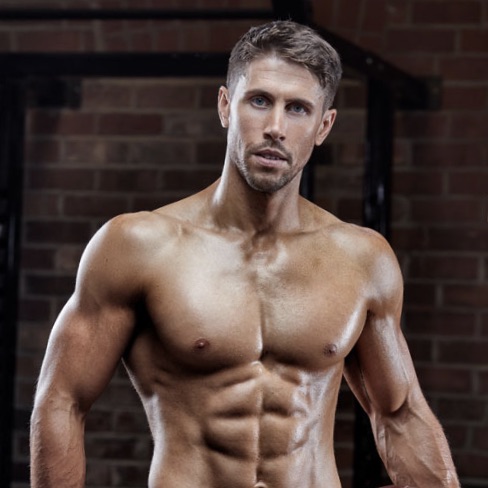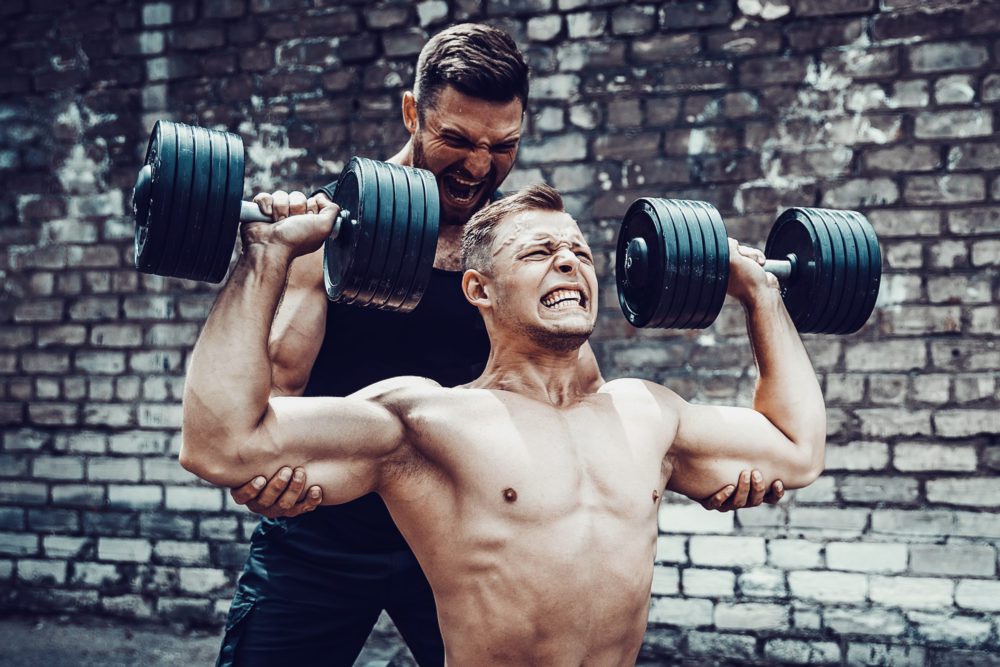Having a high tolerance for pain might sound impressive to some, but when it comes to lifting heavy then pushing through is a bad idea. The key to longterm progress is to find exercises that avoid unwanted pain and discomfort, while allowing you to progressively lift more over time. Having a big box of tools helps. Here are some swaps you might want to consider when back, knee or shoulder pain comes knocking.
Try these for shoulder pain-free overhead pressing
Banged up shoulders shouldn’t get in the way of building them stronger. And don’t worry, there’s no need to ditch your overhead presses just yet. Landmine Shoulder Presses are a simple and solid solution to pressing overhead without the shoulder pain.
The angle and neutral grip of the Landmine helps to reduce the level of shoulder impingement. The thickness of the grip also has an irradiation-type effect. Increasing the grip challenge forearm activation has an internal stabilization effect at your shoulders.
Landmine Presses can be done in a variety of positions. In the video above you’ll see a half-kneeling version, but your could also go with a standing or split-stance position. Apart from the half-kneeling position itself offering some unique benefits, it also changes your height.
As you change your height relative to the natural arc of the landmine then you alter your pressing angle. While at standing height you’re pressing the landmine at more of a horizontal angle, and might be good for early stages of rehabilitation, a half-kneeling position takes that angle a little closer to overhead. Alter your angles accordingly.
Choose the setup and pressing angle that feels most comfortable. If you don’t have a landmine or want to ruin the corner of the room, then either of the MacGyver-like setups below can be used.
Avoid back pain when deadlifting
Unless you’re stuck in the middle ages then you’ll know that the Barbell Deadlift is far from suited to everyone. While having a strong hip-hinge is important, there aren’t many Coaches that would consider straight bar Deadlifting from the floor to be the best and only option – not for the collegiate football stud, nor your 60 year old neighbor who wants to feel strong and delay father time.
Many have learned this lesson the hard way. Some just begin by taking their start position a few inches off the floor to stay within their active range of motion while avoiding existing pain, while others use different bars and modifications. The Trap Bar Deadlift is a good example, and typically involves less hip-flexion while allowing you to keep the bar closer to your hips. Most trap bars also start higher off the floor than a barbell, or have varying handle heights so you can stay away from uncomfortable ranges of motion.
Romanian Deadlifts
For muscle-building purposes though, Romanian Deadlifts (RDL) are better for glutes and hamstrings development. When experiencing pain, the key with RDL’s as with regular deadlifts are to modify the lift so you can keep the load close to your hips (outside your hips or between your legs). RDL’s with a trap bar are a good option, as are Kettlebell or T-Bell RDL’s.
The Landmine RDL has a similar feeling to that of a Kettlebell RDL, but unlike a kettlebell you have vastly greater loading options – from donut weight plates to stacks of wheels you can add whatever you like, and in as small increments as you’d like.
You can adjust the height of your Landmine RDL start position by using different size plates, elevating yourself or the plates off the floor with a step, or using different grips. Setting the right height can act a depth gauge and allow you to avoid painful ranges of motion. Using Angles-90 Grips are one of the most comfortable ways to grip the bar. You can also use an extra plate on the end of the bar to avoid grip issues.
Put the middle-finger up to knee pain when squatting
If you need a zimmer frame for your cranky knees after every squat workout, then you might want to rethink your approach. Whatever’s causing the pain, you need to accept that it’s probably not going away by your next legs workout. It’s also going to hang around for longer unless you find a smarter way to squat.
Spanish Squats reduce knee compression potentially allowing you to squat without pain. They’re great for managing symptoms and flareups associated with patella tendinopathy. Using a heavy kettlebell or dumbbell in a Goblet position also shifts the load to create a more lower-body friendly (and challenging) squat.
The band acts two-fold. First, it decompresses the knee by somewhat drawing it anteriorly. Second, the band allows you to shift your weight more posteriorly.
Sitting back more reduces the angle of the knee and creates a more vertical tibia when squatting. The more you sit back the more vertical your shin remains, although this can be at the expense of the load you’re using. Manipulate accordingly.
Having a resistance band below your knees when squatting loads you further in to terminal knee extension at the top of the movement (think leg extension machine). Driving your knees back in to the band as you stand will increase overall quadriceps activation, particularly targeting the VMO (Vastus Medialis) muscle. Your VMO is important for stabilization of your patellar (knee cap) which is good for overall knee health. Spanish Goblet Squats are a useful pain-free squat to build your quads.
Eliminate shoulder pain when bench pressing
Barbell Bench Pressing with shoulder pain is a bad idea. Unless your sport requires you Bench Press with a straight barbell, pushing through a Benching session with shoulder pain is a dumb move. There are many-many better options, and for a variety of purposes. That being said, if you can’t bare the thought of Bench Pressing without your beloved barbell there are a few options.
The most compromised and painful position in a Bench Press is often the first few inches off your chest. You can have the best setup in the world, glue-up your scapular and overarch your back to avoid it as much as you want. But, that’s not doing anyone any favors. Instead, you can either avoid the position by using more floor or board presses, or you can unload that position while still maximally loading the rest of the movement. A shoulder-saver band setup would does just that. Watch until the end of the video to see how the resistance band is properly positioned.
Similar to the Mark Bell Slingshot band, using a long strength band double-looped can allow you to press pain-free. For this I like the NT-Loop. Twist the band in the middle to create a figure-8. Then fold in half to double-up the band. Position below your shoulders on both arms, ensuring the band is in contact with your upper arms throughout – too close in to your arm pits and the band becomes ineffective as you press.
Try reversing your grip
If you don’t have access to a resistance band then one simple alternative would be to try pressing using a reverse grip. You may want to use a partner to help un-rack the bar, or alternatively you can switch your grip around after you lower to your chest.
Bench Pressing with an underhand grip reduces the angle at your shoulders making them hard to flare. This is a better position for your shoulders to be in if they’re a little banged-up. Reverse Grip Pressing also activates the long-head of your bicep, increasing shoulder stability as you press.
The Reverse Grip Bench Press recruits more upper pec fibers than your regular Barbell Bench Press, too. For pain-free pressing and a bigger chest, ditch the ego lifts and try these smarter alternatives.
Do this to eliminate low back pain during bent-over rows
Shoving your butt against a wall during Bent-Over Rows is a very simple solution to reducing loading of your lower back. Often not considered, Bent-Over Rows of all types can cause existing back conditions to flare-up. An overly fatigued lower back (possibly via a previous exercise) can also hold you from lifting heavy enough to stimulate your upper back when rowing.
Sitting against the wall shifts your centre of mass further back. This essentially shortens the distance between your hips and the load. The result of this is less torque through your spine (assuming you’re lifting the same weight as before), and less likelihood of a cranky of overly-fatigued lower back. Chest-Supported Rows (chest on a bench) can be another solution, but from my own coaching experience some ladies can find them awkward.
An EZ Bar Row is a novel way to hit your mid-traps and rhomboids, and using an underhand grip are extremely comfortable to perform. But, if you’re currently using something more conventional like a barbell or dumbbells you’ll do best to try progressing with that first, with your butt against the wall.
Closing thoughts
Unless you’re feeling an exercise where and how you should, that exercise has no business in your training plan. Delete it and substitute instead for an exercise that is worth your time and effort. To avoid pain or otherwise, selecting better exercises will bring faster results and superior gains in the long-haul.

I build Olympians, Cover Models and those who want to look like them. Author or “Ultimate Abs” available in all good book stores.
